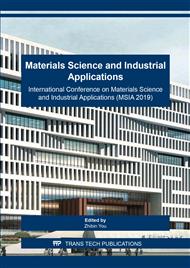[1]
Q. Lei, Z. Xiao, W. Hu, B. Derby, Z. Li, Phase transformation behaviors and properties of a high strength Cu-Ni-Si alloy. Mater. Sci. Eng. A. 697 (2017) 37-47.
DOI: 10.1016/j.msea.2017.05.001
Google Scholar
[2]
S. J. Zinkle, Evaluation of high strength, high conductivity CuNiBe alloys for fusion energy applications, J. Nucl. Mater. 449 (2014) 277–289.
DOI: 10.1016/j.jnucmat.2013.09.007
Google Scholar
[3]
D. Lu, J. Wang, W. Zeng, Y. Liu, L. Lu, B. Sun, Material properties of high-strength beryllium-free copper alloys, Mater. Sci. Eng. A 421 (2006) 254-259.
Google Scholar
[4]
X. Zuo, J. Zhu, B. An, K. Han, R. Li, E. Wang, Influence of Fe Addition on Microstructure and Properties of Cu-Ag Composite Met. Mater. Int., Vol. 23, No. 5 (2017) 974-983.
DOI: 10.1007/s12540-017-6656-2
Google Scholar
[5]
Y. Shen, M. Xie, J. Bi, G. Zhang, W. Guan, M. Wen, S. Wang, Effects of different preparation techniques on mechanical property and electrical conductivity of Cu-8wt%Ag alloy by continuous casting, Rare Metal Mater. Eng. 45 (2016) 1997-2002.
DOI: 10.1016/s1875-5372(16)30161-8
Google Scholar
[6]
J. Lin, L. Meng, Effect of aging treatment on microstructure and mechanical properties of Cu-Ag alloys, J. Alloy. Comp. 454 (2008) 150-155.
DOI: 10.1016/j.jallcom.2006.12.073
Google Scholar
[7]
X. W. Zuo, R. Guo, C. C. Zhao, L. Zhang, E. Wang, K. Han, Microstructure and properties of Cu-6wt%Ag composite thermomechanical-processed after directionally solidifying with magnetic field, J. Alloy. Comp. 676 (2016) 46-53.
DOI: 10.1016/j.jallcom.2016.03.127
Google Scholar
[8]
J. Luo, W. Li, Y. Yu, Effects of Ti addition on grain growth of Cu-Al-Ni alloy cast by heated mold continuous casting process. Journal of Guangdong Non-Ferrous Metals. 16 (2006) 31-35.
Google Scholar
[9]
Ohno A. Continuous casting of singls crystal ingots by the O.C.C process. Journal of Metals, 38 (1986) 14-16.
Google Scholar
[10]
S. Ozawa, T. Motegi, K. Kuribayashi. Unidirectional solidification of aluminum–indium monotectic alloys by ohno continuous casting. Materials Transactions. 45 (2004) 353-356.
DOI: 10.2320/matertrans.45.353
Google Scholar
[11]
M. Okayasu, S. Takeuchi, Mechanical strength and failure characteristics of cast Mg–9%Al–1%Zn alloys produced by a heated-mold continuous casting process: Fatigue properties. Mater. Sci. Eng. A. 600 (2014) 211-220.
DOI: 10.1016/j.msea.2014.01.098
Google Scholar
[12]
J. Luo, Formation mechanism of surface segregation in heated mold continuous casting Al–Cu Alloy. Light Metals 2018. (2018) 435-439.
DOI: 10.1007/978-3-319-72284-9_59
Google Scholar


